THE ROYAL GREEN JACKETS
The Oxfordshire & Buckinghamshire
Light Infantry
(43rd & 52nd)
Foundation
The eighteenth century saw Great Britain and France intermittently at war, both on the continent of Europe and throughout their colonial territories, and the British Army was continually expanded and reduced to suit the needs of the moment. One such expansion, in 1741, included the raising of the 54th Regiment of infantry with its headquarters at Winchester. Disbandments at the end of the war in 1748 spared the regiment, by then in garrison at Minorca, but reductions amongst older regiments caused its renumbering as the 43rd. In 1755 another 54th Regiment was raised and based at Coventry, to be renumbered the 52nd a year later.
The
Seven Years' War (1756-63)
The American War of Independence (1774-82)
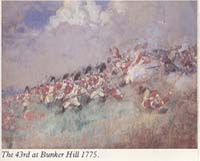
The
43rd returned to England after the peace of 1763 but crossed the Atlantic
again eleven years later and was engaged throughout the American War of
Independence. The 52nd, which had waited twenty
years for its first taste of active service, joined them at Boston and the
two regiments fought side-by-side at Lexington and Bunker Hill, both
battles won at the cost of heavy casualties.
Southern
India (1783-96)
The
West Indies -Second Round (1794-1800)
The
Light Brigade
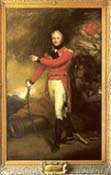
Sir John Moore
For some fifty years before 1800 it had been the
practice for infantry battalions to include a light company of picked men
for tasks needing rapid reactions when, in 1803, the 43rd and 52nd were
chosen to form the first Corps of Light Infantry and joined with the 95th
Rifles (later The Rifle Brigade) to constitute the Light Brigade at
Shorncliffe in Kent under the command of Sir John Moore.
Moore has been described as ‘the very best
trainer of troops that England has ever possessed’. His insistence on
absolute professionalism and mutual respect between officers and men (new
concepts at the time) was to create a formation whose contribution was
crucial to Wellington's victories in the Peninsula and whose traditions
survive in The Royal Green Jackets of today.
Copenhagen
(1807)
In
1807, Denmark having allied itself with France, the 43rd, 52nd and 95th,
led by Sir Arthur Wellesley, the future Duke of Wellington, were part of a
force which bombarded and captured Copenhagen and with it the entire
Danish fleet. Disaster almost struck on the voyage home, when a ship
carrying the 43rd ran aground in a storm. Sure that their last hour had
come, an officer produced a flute and played the 'Death March in Saul',
but ship and regiment in the end survived.
The
Peninsular War (1808-14)
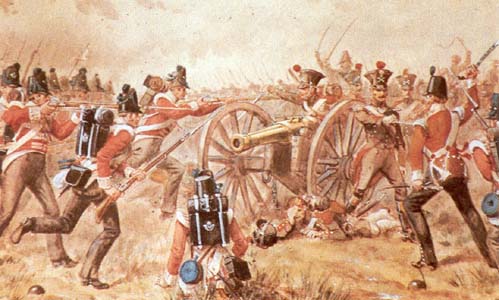
When
Napoleon's armies invaded Spain and threatened Lisbon in 1808 the 43rd and
52ad were in Wellesley's force sent to oppose them and played a central
role in the sharp engagement at Vimiera (where all four future Green
Jacket regiments took part) which forced the French to evacuate Portugal.
When Sir John Moore succeeded to the command and advanced into Spain, two
battalions of each regiment were in his army and, with the 95th, played a
distinguished part in forming the rearguard when the army was forced to
retreat in mid-winter to Vigo and Corunna. Moore was killed in the final
battle but his army was able to embark in good order and return to
England.
The
following year the reconstituted Light Brigade returned to the Peninsula
under Robert Craufurd, landing at Lisbon. Hearing that their support was
urgently needed in Spain, they set out at once on a forced march of 250
miles, the last fifty-two in twenty-six hours, to join Wellington's army
at Talavera, but arrived on the battlefield only to find that the battle
was already won. Meanwhile the 2nd Battalions of each regiment were
despatched on a disastrous expedition to Walcheren in the Low Countries
where they were decimated by fever without achieving anything of value.
With the addition of two battalions of Portuguese light infantry the Brigade grew into the Light Division and for the next four years was continuously the cutting edge of Wellington's force until the French were driven out of Spain. By that time it had fought another dozen great battles and sieges and as many lesser actions. At the capture of Ciudad Rodrigo Lieutenant Gurwood of the 52nd commanded the 'forlorn hope' and received the French Governor's sword in surrender.
North
America (1814-15)
Waterloo (1815)
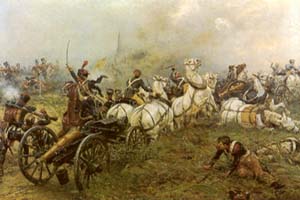
52nd
at Waterloo
The
Kaffir Wars and the Birkenhead (1851-53)
The
Indian Mutiny (1857-59)
Campaigns
from 1863-1902
Amalgamation
World
War I (1914-19)
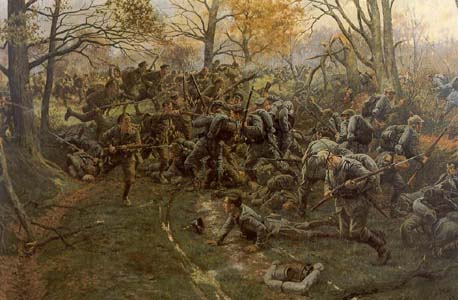
The 1st Battalion (43rd) fought the
Turks in Mesopotamia, where they suffered very heavy casualties, were
besieged at Kut and eventually starved into surrender. Of 300 men who were
taken prisoner only ninety survived the war. In 1919 the reconstituted
battalion took part in the inconclusive campaign against the Bolsheviks in
North Russia.
The 52nd and most of the affiliated Territorial Force battalions fought on the Western Front. In 1914 they achieved fame at Nonne Boschen by routing the Prussian Potsdam Guards, almost 100 years after they had defeated the French Imperial Guard at Waterloo. From then on, however their experiences of appalling casualties for little apparent gain mirrored those of the rest of the Army. Other battalions fought in Italy and Salonika.
World
War II (1939-45)
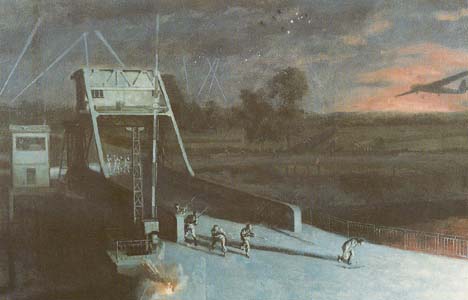
The 43rd and 1st Bucks Battalion (TA) were in
the British Expeditionary Force in France in 1940 and escaped through
Dunkirk after suffering heavy casualties. Another TA battalion (4th Oxf
Bucks) was encircled by the Germans and overrun. The regiment was
represented by the 7th Battalion in Tunisia and Italy (at the Anzio and
Salerno landings), the 43rd in North-West Europe (in the advance from
Normandy to Hamburg) and by the 6th in Burma (from Arakan down the west
coast to Tamandu).
The 52nd was chosen to pioneer the new role of air landing by glider. At midnight before the D-Day landings in Normandy coup de main parties from the battalion siezed and held the bridges over the Caen Canal (Pegasus Bridge) and River Orne (Horsa Bridge). In March 1945 the battalion carried out a costly assault landing as part of the operation to cross the Rhine before fighting its way across Germany to meet up with the Russians on the Baltic.
The Post-War Years (1945-1958)
After the war the 43rd were engaged in
peace-keeping in Trieste and Yugoslavia while the 52nd faced the Jewish
uprising against the British mandate in Palestine. In 1948 the two
Battalions amalgamated to form the 1st Battalion The Oxfordshire and
Buckinghamshire Light Infantry, 43rd and 52nd, which was in Greece during
the Civil War, in Egypt and in Cyprus confronting the Enosis insurgents
demanding union with Greece. There in 1958 it once more changed its title
to the 1st Green Jackets (43rd and 52nd) and in 1962 was the first
battalion to take part in the Borneo Campaign.